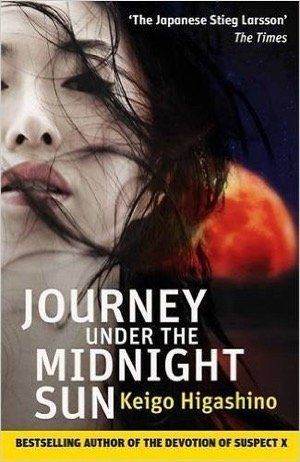Translated by Alexander O Smith — It’s no exaggeration to say that Keigo Higashino is a phenomenon in Japan. Popular and multi-award winning, he’s been putting out books steadily for the past 30 years, which means there’s a rich vein of potential translations to mine. Journey Under the Midnight Sun is a dark, convoluted tale, marked by Higashino’s characteristic sleight of hand.
The novel opens in Osaka in the early 1970s – Homicide Detective Junzo Sasagaki is taking a walk on his day off when he sees a group of police cars converge on an abandoned building. A group of children playing inside the building have found the body of a pawnshop owner, stabbed through the chest with a thin, sharp blade. Sasagaki’s investigation unearths more questions, and shines a light on some possible infidelities and family quarrels, but never reaches any conclusions. One of his chief suspects, the partner of a woman who the pawnshop owner visited on the day of his death, dies in a car crash soon afterwards. Though Sasagaki’s suspects there is more to the deaths, the case is abandoned. But Sasagaki never quite gives up on it.
There are several things that don’t sit right with him – several alibis are suspicious, and motives are hard to establish with any conviction. When the woman who the pawnshop owner was visiting the day he died is found dead in her apartment, in what looks like suicide, Sasagaki again feels something is amiss. However, the police focus on the wellbeing of her daughter Yukiho, newly orphaned, who leaves everyone who meets her with a distinct sense that she is older than her 12 years.
The narrative lurches forward repeatedly, and jumps between characters, making Journey Under The Midnight Sun hard to follow at times. Readers familiar with Higashino’s work will be waiting for the moment when the author shows his full hand, and the whole narrative comes together. In this case, you’ll have to wait a little longer than usual due to the sheer size of the novel. Journey Under the Midnight Sun is not only big in terms of its 500 pages, but also in complexity. Higashino’s strength is the way in which he tricks us into searching for a clue that’s sitting in plain sight the whole time. In Japanese, a language known for its indirectness, this is simple, and it’s no mean feat translating this into English without giving away too much.
Despite this, if you’re familiar with other books of Higashino‘s in English you might find yourself frustrated by certain aspects here. For a start, the story is episodic in nature, perhaps due to the fact the original was serialised in a literary magazine. This leaves us grasping for links between chapters, which don’t become apparent until half way through. The timeline can be a struggle as well, with references to computer technology, video games, baseball and Japanese current affairs dropped in to hint at when the action is occurring. While you might be familiar with the bursting of the Japanese asset price bubble, or Super Mario Brothers, most of us probably don’t know when the Hanshin Tigers broke their title drought, or when the findings of the inquest into Minamata disease were handed down.
However the complexity of the timeline and the difficulty in following the references only serve to add to the other strength of Higashino’s work, which is shared with Maj Sjöwall and Per Wahlöö in their Martin Beck novels. This is his ability to get into the heart of a specific time period, while simultaneously looking deep into the hearts of his characters. It makes Journey Under the Midnight Sun well worth reading.
A Midsummer’s Equation, with Detective Galileo from The Devotion of Suspect X, is due in early 2016. The author’s previous book, Malice, was one of our top books of 2014 and you’ll find more Japanese crime fiction here.
Little, Brown
Print/Kindle/iBook
£8.99
CFL Rating: 4 Stars









